| |
May'45-early'49
This taillight housing is also used for the KDF models (prior
to May'45) as well, but we will stick to the post war models.This
taillight assembly uses a large chrome plated bezel that surrounds
the lens, and is housed with a metal housing. The taillights
on these models served as running lights only. The brake light
was housed within the license housing.
|
 |
 |
Early'49-1949
The large chrome plated bezel is omitted, and a smaller aluminum
bezel is installed. The housing is also slightly different
in shape. The brake light function is still controlled within
the license light housing. |
 |
 |
1950-Sep'52
The aluminum ring is deleted, thus losing some flair. All
other aspects remain the same. Hella and Hassia produced these
assemblies interchangeably.
|
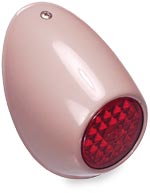 |
 |
Oct'52-1955
European models, Oct'52-Sep'54 (chassis #1-0722915) U.S.,
Guam, and Canadian models.
VW incorporates the brakes light operation within the taillights,
and will remain throughout the production run of the Beetle.
This taillight uses two lenses, one upper and one lower. The
upper lens is red plastic (some versions are amber) and functions
as the brake light, while the lower lens is glass and serves
as the running light. The lower lens is surrounded by a chrome-plated
bezel. The original version did not have a provision for water
drainage. As a result, many of these units rusted from the
inside out. Starting on October 18, 1954, chassis # 1-0734000,
a weep hole is drilled into the bottom portion of the housing
to allow for water drainage. Hella and Hassia produced these
taillights interchangeably.
|
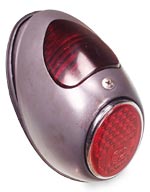 |
 |
|
Oct'54
(chassis # 1-0722916) - May 2, 1955 (chassis 1-0871207)
U.S., Guam, and Canadian models.
This is probably the most misunderstood taillight assembly
of them all! Most people refer to these as "1955 only"
taillights. We will set the record straight on these, so
forget everything you heard, or thought you knew!
Dimensionally speaking, this taillight is the same size
as the Oct'52-July'54 assemblies. The upper brake light
lens is deleted, and the lower lens is constructed of dark
red, convex shaped dark red plastic and is surrounded with
a chrome bezel. The brake and running lights were illuminated
through this lens.
Here is yet another twist for this particular taillight
assembly. From April 1, 1955 through May 2, 1955, VW offered
as a factory accessory a flashing indicator package for
Beetles bound for the U.S., Guam, and Canadian markets.
Beetles equipped with this option were outfitted with "bullet"
style front flashing directional indicators (in place of
semaphores), and a larger
style rear taillights that controlled the brake, running
and directional lights. We receive many questions from people
restoring 1954-1955 Beetles with regards to what taillight
is correct. Here is a condensed breakdown of how to determine
which taillight is correct for your car:
**All 1954-1955 European Beetles were outfited with "heart"
taillights.
**All Oct'54 (chassis # 1-0722915) - Mar'55 U.S., Guam,
and Canadian market cars used the red convex plastic lens
taillights. All of these cars had semaphore directional
indicators.
**April'55
- May 2, 1955 (chassis # 1-0871206) U.S., Guam, and Canadian
market cars, there are two possibilities. Your car could
have the red convex plastic lens taillights and semaphores,
or it could have the optional flashing turn signal package
with the larger glass taillights and "bullet"
style front flashing directional indicators.
**May
3, 1955 (chassis # 1-0871207) - July'55 (chassis # 1-0929746)
U.S., Guam, and Canadian market cars were equipped with
the flashing indicator package as standard equipment. So,
this car would have the larger glass taillights and "bullet"
style front directional indicators.
|
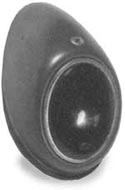 |
 |
1956-1961
The taillights increase in size, and are placed 60mm higher
as compared to the previous span of years. This taillight
consists of a red glass ovular shaped lens, which is surrounded
with a chrome bezel. This taillight first appeared in
April 1955, as an option for U.S., Guam, and Canadian market
cars. Hella and Hassia produced these assemblies interchangeably.
|
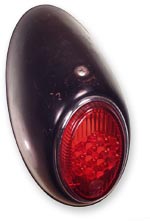 |
 |
1962-1967
A little larger, yet! A radical new design is adopted that
uses an ovular shaped plastic lens, which is surrounded with
a chrome bezel. The taillight lens color differs from market
to market. All U.S. and Canadian export models utilize red
lenses, while all other markets use two-tone red/amber lenses.
These taillights now use two separate bulbs to control running,
brake, and directional illumination. Hella was the exclusive
manufacturer of this assembly.
|
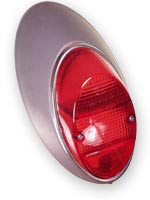 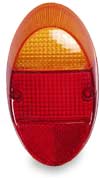 |
 |
1968-1969
You guessed it, a little larger yet again! VW incorporates
a back-up light within the taillight assembly, which is the
lower white area of the lens. All U.S. and Canadian export
models utilize red lenses, while all other markets use two-tone
red/amber lenses. These taillights now use two separate bulbs
to control running, brake, and directional illumina
tion. Hella was the exclusive manufacturer of this assembly.
1970
This assembly is the same size as the 1968-1969 variety, however
two reflectors are added to the assembly. One in installed
on the inner, lateral-facing side of the lens, and the other
is mounted on the lateral facing side of the metal housing.
The inner reflector is translucent white (pointed out in the
picture below) while the outer is red. All U.S. and Canadian
export models utilize red lenses, while all other markets
use two-tone red/amber lenses.Hella was the exclusive manufacturer
of this assembly.
|
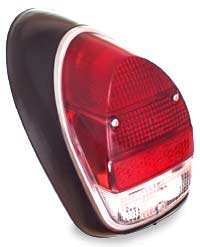 |
|
|
 |
1971-1972
The taillight increases in size once again, but still has
the relative shape of the 1968-1970 variety. The outer lateral-facing
reflector remains unchanged. All U.S. and Canadian export
models utilize red lenses, while all other markets use two-tone
red/amber lenses. Hella was the exclusive manufacturer of
this assembly.
|
 |
 |
|
|